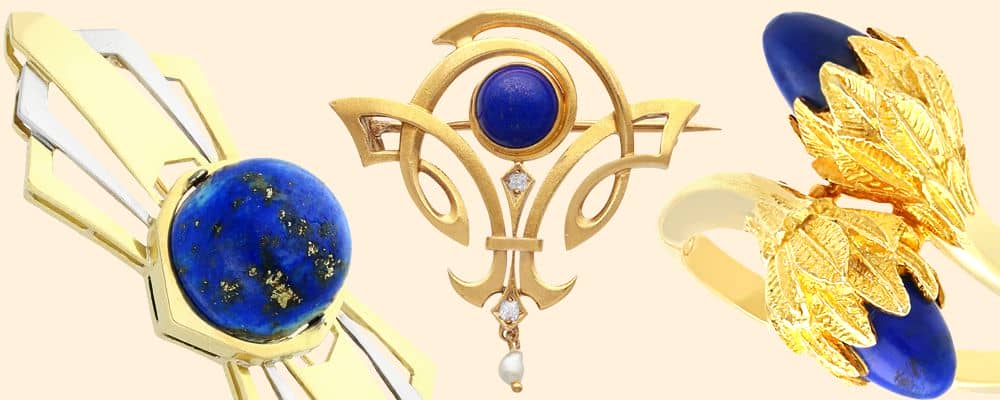Lapis Lazuli Jewellery
Antique and Vintage Lapis Lazuli Jewellery for Sale
Shop our stunning collection of vintage and antique lapis lazuli jewellery for sale at AC Silver. Including fine Victorian necklaces and vintage gold rings featuring the gemstone.
Lapis lazuli can be seen featuring various shades such as indigo, royal, midnight, or marine blue, the distinctive color of lapis lazuli ranges from slightly greenish-blue to violetish-blue, with a medium to dark tone and high saturation.
Find the perfect piece of lapis lazuli at AC Silver with free insured shipping and a 14 day return policy.

Lapis Lazuli Jewellery Frequently Asked Questions
As can be expected for such a unique stone, lapis lazuli was held in high regard by the ancient cultures of Greece, Rome, Egypt, and Mesopotamia to name a few. It is believed that many historical references to sapphires are more likely references to lapis lazuli.
One of the main sources of lapis lazuli is in former Bactria, now Afghanistan. Nestled within the arid mountains of this deserted region are lapis lazuli deposits. There are few signs of life in this area, with no vegetation, little animal activity, and sheer mountains reaching more than 16,000 feet in height. Despite these harsh conditions, humans have made their way to the Badakhshan province using donkeys to carry their equipment for more than 2,000 years for the sole purpose of mining lapis lazuli. Even today, this area is still a prominent producer of the rich blue gemstone, making it the oldest known gemstone source in the world.
Since the inception of its use, lapis lazuli has been a popular component of jewellery. Common gemstone cuts for lapis lazuli include cabochon cuts as well as rough cuts, allowing the stone's natural beauty to show through without the need for a faceted finish. In fact, the gemstone is so dense with colour that faceted cuts are rarely used, as light cannot enter the stone. Because of its easily-mouldable texture, lapis lazuli has also been a popular carving material since its discovery.
Many Ancient Egyptian excavation digs have unearthed carved lapis lazuli in the form of scarab beetles, birds, and other common Egyptian symbols. In Anatolian discoveries, carved lapis lazuli has taken the form of various fertility amulets. Throughout Ancient Roman excavations, lapis lazuli has been a common feature in everything from signet rings to decorative pieces like jugs and plates.
During the Renaissance period, artists like Michelangelo crushed lapis lazuli into a fine powder, using its rich pigmentation to paint blue scenes like the sky and the sea. The vibrancy of lapis lazuli made it the perfect ingredient for such a bold colour in a time where creating paint pigments was a very difficult and expensive process.
Lapis lazuli has had many meanings across different cultures and time periods. Found in ancient ruins across Europe, Northern Africa, and much of Asia, this gemstone has a far-reaching legacy and thus is linked to a variety of mythology.
In Ancient Mesopotamia, for example, lapis lazuli is inextricably linked to Inanna, the goddess of sex, love, justice, political power, and war. The Queen of Heaven, Inanna was worshipped through the use of lapis lazuli jewellery, as she was believed to don a necklace and staff crafted from the gemstone. Wearing a lapis lazuli pendant, often carved with Inanna's various insignias, was to ask for her blessing in one's endeavours, be they romantic or politically strategic.
A more recent example of lapis lazuli's meaning can be found in 18th and 19th century Western civilisations, where gemstones of all kinds were used among members of court to send discreet messages to one another. Gemstone language, comparable to flower language, was a way in which affection for someone could be declared without drawing too much attention. A piece of jewellery would be gifted featuring a range of different gemstones, with the first letter of each stone representing a letter of the message.
This jewellery was highly popular, with terms such as 'dearest', 'adored', 'beloved' and other affectionate phrases being spelled out through the use of gemstones. Lapis lazuli is the most common gemstone to use when representing the letter 'l', and has thus generated an intricate connection with love and affection.
Today, the lapis lazuli is often connected to the concept of wisdom, truth, and an almost divine sense of knowledge. It is likely that this connection has in part been made largely due to lapis lazuli's omnipresence in ancient cultures around the world. Such a ubiquitous stone generates an air of mystery and knowing that can seem beyond our understanding. One of the most recognised pieces of art in the modern world is the mask of Tutankhamun, which heavily features inlays of lapis lazuli. The contrast between the rich blue of the lapis lazuli and the gold of the mask also denotes a sense of royalty and majesty, with which the stone is still heavily associated.












